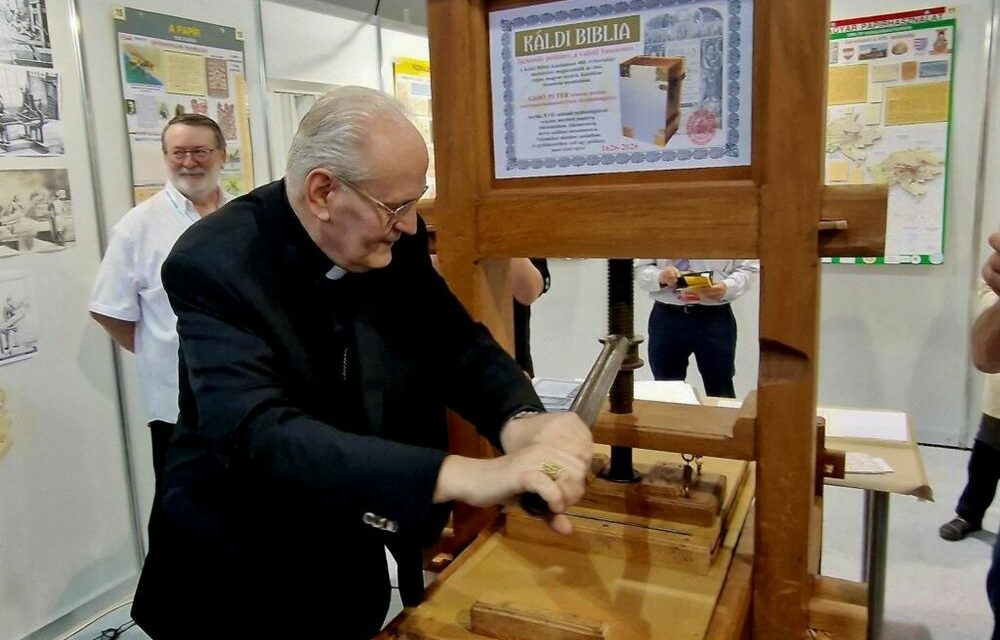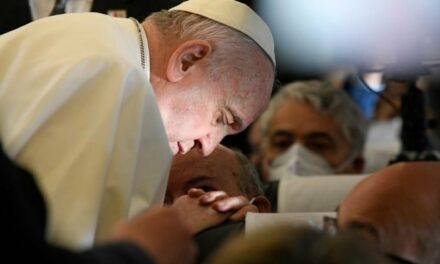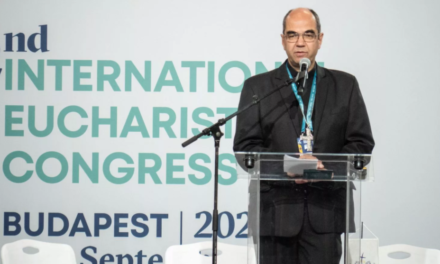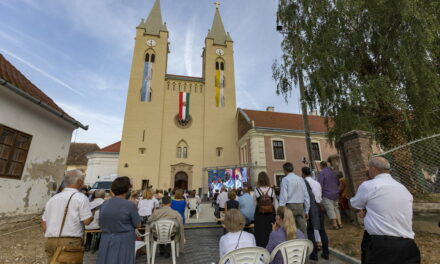For the 400th anniversary of its publication, in 2026, the Káldí Bible will be republished with original technology. The first page of the 400 copies of the facsimile edition was printed by Cardinal Péter Erdő, Archbishop of Esztergom-Budapest, on Wednesday in Budapest, on a period-correct Gutenberg printing press.
At the event, Péter Erdő spoke about how the first complete Catholic Bible translation is an outstanding piece of Hungarian culture and language history.
He recalled: the medieval manuscript codices already contain passages of the Bible in Hungarian, which were prepared by monks for the use of nuns and more educated believers. He mentioned the Munich Codex and the Jordánszky Codex preserved in the Cathedral Library in Esztergom as examples.
However, with book printing, the demand for printed Bibles appeared, and with the Reformation, a kind of competition between denominations also developed.
He explained: firstly, they printed so-called postilla books, collections containing the Sunday Gospels, possibly holy lessons and readings, as well as their explanations.
Such was Miklós Telegdi's three-volume book of postils, written for the Sundays and holidays of the entire church year, the first volume of which he published in Vienna, at Máté Formika's printing house. However, to print the second volume, he already bought a printing press, which he set up in his own house in Nagyszombat. Thus, it became the first book of postils published in Hungary by a Catholic author.
This was followed by the first complete Bible translation by the Protestant Gáspár Károli, and then the first complete printed Bible translation by the Catholic György Káldi in 1626.
The language of Káldi's translation is much more modern
The cardinal highlighted: the language of Káldi's translation is much more modern than that of either the Telegdi postulates or the Vizsolyi Bible. Therefore, the Hungarian language changed enormously in a few decades, and the "main engine" of this change was Péter Pázmány and his circle, who consciously modernized the Hungarian language. He added that the next language reform on such a scale took place during the time of Ferenc Kazinczy.
He went on to say that the Káldí Bible helped the Hungarian text of the scriptures reach all Catholic priests, Catholic families and the few monks who remained during and after the Turkish era.
Péter Erdő emphasized that the popular opinion that the church wanted to close the text of the Bible from the faithful is not true. This is proven by the fact that although the Kaldi Bible was not published as often as the Protestant Bible translation, its number of copies was much larger than that of Vizsolyi.
Based on the catalog of the Old Hungarian Prints, the Káldi Bible from that era appears in the most copies in the public collection, he explained.
The cardinal also noted that several facsimile editions of the Káldí Bible have already been published. All are "respectable enterprises" that present challenges to publishers, as it is difficult to find period-correct paper for printing, for example.
Named, serially numbered copies
The publisher, Mihály Daruka, said that with the 400 Káldi Bibles he built using a printing press using 16th-century technology, they wanted to celebrate the anniversary on the one hand, on the other hand, they wanted to pay tribute to the printers who came before us, and on the third hand, they wanted to try out how book printing was done 400 year ago.
"Until we see where we started from, we don't even understand how far we've come," he said.
Mihály Daruka also reported that the numbered copies of the 400 Bibles will be given to those who support the implementation of the Hungarian Printing Industry Historical Experience Museum planned in Kehidakustány. The handover of the museum is planned for 2025, he said.
György Káldi was born in Nagyszombat in 1573. He studied theology in Vienna in 1595, was ordained a priest in 1597, and entered the Jesuit order in Rome in 1598. In 1625, with the support of Pázmány, he founded and equipped the Bratislava college with a printing press, of which he was rector until his death. At the request of Pázmány, he worked on the translation of the scriptures. His first manuscript was made between 1605-1608 using previous experiments. The first complete Catholic Holy Bible in Hungarian, published in Vienna in 1626, was widely distributed and significantly influenced the development of the Hungarian literary language.
MTI
Photo: Archdiocese of Esztergom-Budapest












